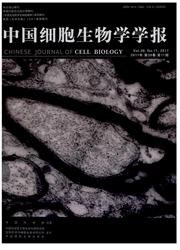

 中文摘要:
中文摘要:
肿瘤转移是导致肿瘤患者死亡的最主要原因,TGF-β超家族成员Nodal分子被证实参与肿瘤细胞的增殖和转移,因而基于Nodal信号为靶标开展抗肿瘤研究成为可能。该研究应用Western blot检测乳腺癌细胞株BT-549、T-47D、MCF-7、SK-BR-3和MDA—MB-231中的Nodal和基质金属蛋白酶-2(matrix metalloproteinase-2,MMP-2)的表达水平,发现它们在BT-549细胞中表达量最高。然后采用不同浓度_Nodal信号抑制剂SB.431542(1-50μmol/L)处理BT-549细胞48h,利用MTT法揭示20~50gmol/L的SB-431542抑制该细胞增殖。进一步利用细胞划痕和Transwell实验证明,10μmol/L的SB-431542可抑制乳腺癌细胞的迁移和侵袭。最后,通过明胶酶谱和Westernblot显示,10~30gmol/L的sB.431542可剂量依赖性地抑制MMP-2的表达和活性。上述结果说明,SB-431542通过阻断Nodal信号通路可效抑制乳腺癌细胞BT-549的增殖、迁移和侵袭,其作用机制可能与降低MMP-2的表达和活性有关。
 英文摘要:
英文摘要:
Metastasis is the main cause of death in patients with malignancy. Nodal, as a member of TGF-β superfamily, promotes the proliferation and metastasis of tumor cells. In this study, we hypothesized that SB-431542 as a membrane receptor-specific inhibitor of Nodal may affect the tumor properties of breast cancer cell through blocking Nodal signaling pathway. The expressions of Nodal and matrix metalloproteinase-2 (MMP-2) were detected by Western blot in breast cancer cell line BT-549, T-47D, MCF-7, SK-BR-3 and MDA-MB-231, showing that the expressions of Nodal and MMP-2 were stronger in BT549 than that in other cell lines. After the BT549 cells were treated with increasing concentrations (1-50 μmol/L) of SB-431542 for 48 h, SB-431542 (20-50 μmol/L) signifi- cantly inhibited cell proliferation but 10 μmol/L of the inhibitor had no effects. Furthermore, wound healing and Transwell assays demonstrated that 10 μmol/L of SB-431542 could block breast cancer cell migration and invasion, respectively. By gelatin zymography and Western blot, it was revealed that the expression and activity of MMP-2 but not MMP-9 were significantly suppressed by this inhibitor in a dose-dependent manner when BT-549 cells were treated by SB-431542 (10-30μmol/L) for 48 h. Taken together, these results indicated that SB-431542 inhibited the migration and invasion of breast cancer cells through blocking Nodal signaling pathway, which might be related to the down-regulation of MMP-2 expression and activity.
 同期刊论文项目
同期刊论文项目
 同项目期刊论文
同项目期刊论文
 Reduced expression of activin receptor-like kinase 7 in breast cancer is associated with tumor progr
Reduced expression of activin receptor-like kinase 7 in breast cancer is associated with tumor progr Regulation of dopamine D2 receptor expression in grass carp pituitary cells: A possible mechanism fo
Regulation of dopamine D2 receptor expression in grass carp pituitary cells: A possible mechanism fo A newly identified epithelial cell adhesion molecule (EpCAM) from grass carp (Ctenopharyngodon idell
A newly identified epithelial cell adhesion molecule (EpCAM) from grass carp (Ctenopharyngodon idell Characterization of grass carp (Ctenopharyngodon idellus) Foxp1a/1b/2: Evidence for their involvemen
Characterization of grass carp (Ctenopharyngodon idellus) Foxp1a/1b/2: Evidence for their involvemen Characterization of two heat shock proteins (Hsp70/Hsc70) from grass carp (Ctenopharyngodon idella):
Characterization of two heat shock proteins (Hsp70/Hsc70) from grass carp (Ctenopharyngodon idella): TGF-beta 1 Exerts Opposing Effects on Grass Carp Leukocytes: Implication in Teleost Immunity, Recept
TGF-beta 1 Exerts Opposing Effects on Grass Carp Leukocytes: Implication in Teleost Immunity, Recept Molecular and functional characterization of grass carp squint/nodal-related 1: a potential regulato
Molecular and functional characterization of grass carp squint/nodal-related 1: a potential regulato 期刊信息
期刊信息
